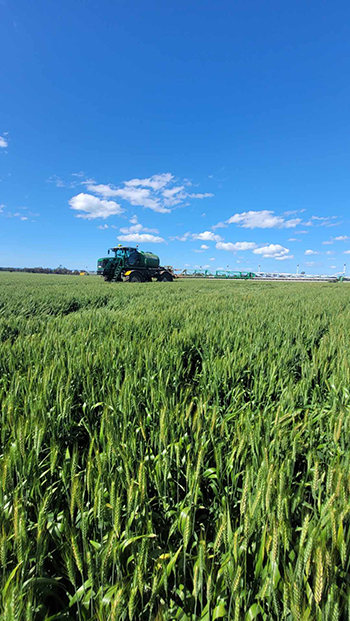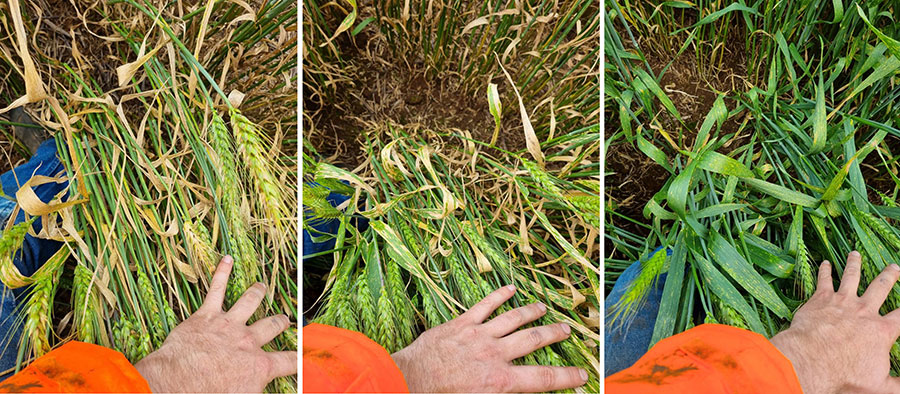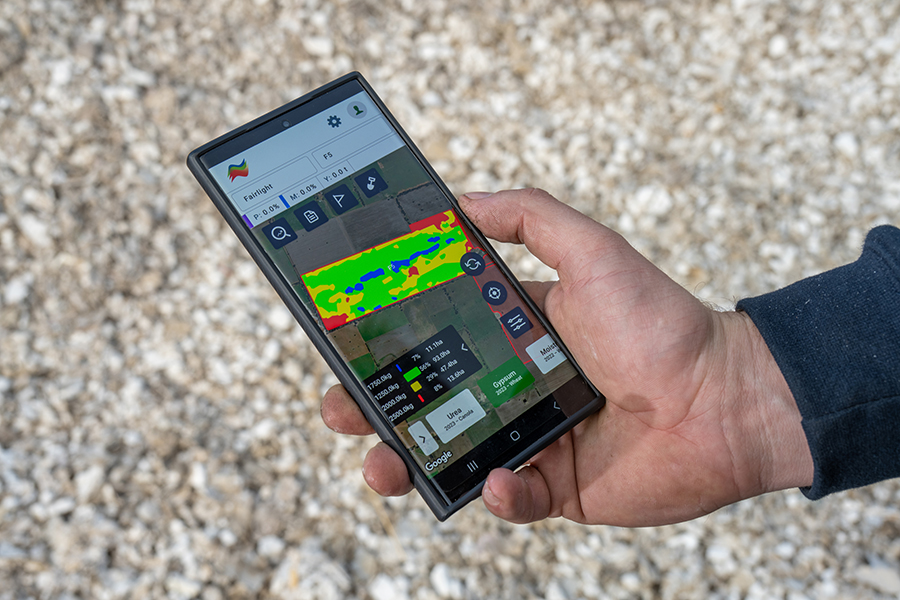Snapshot
Growers: Broden and Chris Holland
Location: Thuddungra, New South Wales
Farm area: 5000 hectares
Area cropped: 4400ha
Average annual rainfall: 600 millimetres (long-term)
Soil types: Sandy clay loam
Topography: Undulating
Soil pHCa: 5.5
Soil pHCa target: 6.0
Enterprises: Cropping and 6000 wether sheep
Crops and varieties: HyTTec® Trifecta, HyTTec® Trophy, Hyola® Blazer TT, RGT Baseline™ TT canola; BigRed (PBR), LRPB Raider (PBR), LRPB Lancer (PBR), Scepter (PBR) and Sunmaster (PBR); and PBA Samira (PBR) faba beans
Crop sequence: Under review but possibly wheat/canola/wheat/canola/fababeans/wheat/canola/wheat/lucerne/lucerne/
Broden and Chris Holland’s investment in a self-propelled boomspray with artificial intelligence (AI) was driven by a desire to boost in-crop spraying efficiency.
The 28-year-old and his father, Chris, grow grain across 4400 hectares – with help from their three employees – between Young and Grenfell, in southern New South Wales.
To manage weeds, the pair in July 2021 bought a sprayer capable of ‘green-on-green’ spraying.
Green-on-green spraying uses video cameras and AI technology to ‘see’ and spray weeds in crops. But the system can also be used for ‘green-on-brown’ spraying to detect and spray weeds in fallow.
Manual rate adjustment
Until 2021, Broden says they used flamprop-m-methyl (Mataven®) to spot-spray black oats in wheat by manually adjusting the section control buttons of their 36-metre Goldacres G6 self-propelled boomspray.
“But we wanted something more precise and automatic to change our herbicide rates in sections on-the-go,” he says.
“We learned the 36m Goldacres G6 self-propelled boomspray fitted with the Weedetect system powered by Bilberry algorithms would allow us to travel up to 24 kilometres an hour, so we jumped in on a trial.”
Image-based spraying
The image-based spraying system comprises 12 six-megapixel video cameras fitted at 2m intervals across a 36m Goldacres G6 self-propelled boomspray.
The cameras collect 16 images per second to identify weeds when spraying in stubbles during summer and in crops.
In the blink of an eye, as the boomspray moves forward, an onboard AI computer with software algorithms recognises weeds and passes this to a screen in the cabin.
Then, the screen in the cabin ‘tells’ the nozzles on the boom to deliver a lethal dose of herbicide to the targeted weeds.
To work accurately, software algorithms rely on massive libraries of weeds. These comprise millions of weed images around which people have drawn boundaries. This allows the AI software to ‘learn’ to see weeds as identifiable shapes.
When the video camera records a weed, it ‘refers’ to this library. If a match is made, the technology sprays the weed.
Broden says continual development of each algorithm can be done by Bilberry as growers can record images and send them back to the company to improve the system further.
For example, he says an algorithm for spot-spraying black oats in wheat is in beta testing and looks “very promising”.
High stubble residues can affect the efficacy of the cameras in some situations, although Broden says he has seen good results in large wheat stubbles in the past two years.
Nevertheless, he and Chris still burn high stubble loads, which also helps to control pests such as millipedes and slugs and a range of stubble-borne disease pathogens.
Broden is particularly satisfied with how the system controls summer weeds.
“Every time I use it during summer to control melons or fleabane, I am amazed,” he says. “It has reduced summer herbicide use by up to 76 per cent compared with blanket spraying, even in two very wet summers.”
In-crop weeds
With one camera scouting for weeds every six nozzles, Broden says they now have the capacity to control annual ryegrass in canola and volunteer canola and radish in wheat.
“Dad and our employees have worked hard over the years to reduce the population of weeds on our farm to very low levels,” he says.
“We’d like to be further ahead with the system than we are, but we want to take our time and collect the data needed to make it work reliably before we rely on it heavily to control in-crop weeds.”
Aside from reducing the cost of herbicide applied, he says AI spot-spraying is also better for the environment because less herbicide is applied in our grain production system.
“Ideally, we’d have our cameras spaced at one-metre sections, covering two nozzles per camera, but one camera per six nozzles is enough for now.”
For optimal in-crop weed management, the manufacturer recommends a two-spray approach because the cameras do not have a 100 per cent hit rate.
But at $4/ha to run the boomspray, Broden would like to refine the system so that only one pass is required, which would also need a sprayer with two tanks.
He says the best-case scenario would be to have a boomspray that can blanket spray atrazine for radish control, for example, and a second tank hooked to the AI system to spot-spray clethodim (Select® Xtra).
Timing crucial
One criticism of camera spraying, Broden says, is the effect of canopy closure on the capacity of the cameras to ‘see’ the weeds.
To target annual ryegrass in canola, he says the technology works best just before canopy closure.
“So far, our Flexi-Coil 820 seeder set on 228.6-millimetre, or nine-inch rows reduces the light available for the cameras to detect weeds accurately.
“If you run your farming system on 304.8mm or 12-inch row spacings, there will likely be fewer issues.
“You need to spend some time fine-tuning the technology to fit your farming system, but Bilberry is dedicated to getting this right, and improvements have already been made to the light issue.
“Earlier this year, we bought a John Deere disc seeder, and it will be interesting to see how the system copes with 190.5mm or 7.5-inch row spacing.
“The narrower rows will let less light in between the crop rows, but it should also increase crop competition against weeds, which will be beneficial.”
Broden says that adding an optional lighting system to the boomspray would likely improve the accuracy of in-crop weed detection.
While there have been some small teething problems with green-on-green spraying, he is upbeat about the technology’s potential, saying that, for now, it is a better fit for his family’s farms than harvest weed seed control.
“We are likely to see it working at full potential in 2024 once all the algorithms have been set up to be specific to our farm.”
Disease management
 The same self-propelled boomspray used to spray weeds using artificial intelligence is also deployed to apply fungicide to prevent disease on the Hollands’ family farm. Photo: Broden Holland
The same self-propelled boomspray used to spray weeds using artificial intelligence is also deployed to apply fungicide to prevent disease on the Hollands’ family farm. Photo: Broden Holland
Less time spent on in-crop spraying also frees the self-propelled sprayer to be deployed to protect crops against disease, which is particularly important in high-rainfall seasons.
Broden says last year’s wetter-than-average season showed that wheat crops, fully protected with fungicide, yielded more grain than partially protected crops.
“Where we could apply fungicides on time, we saw good yield results, but if the timing was poor because the ground was too wet to traffic, grain yields suffered.”
Wheat is routinely protected against rhizoctonia and crown rot by applying flutriafol (Impact®) to monoammonium phosphate.
If conditions are wet during spring, Broden applies epoxiconazole (Opus®) a week before flag leaf emergence.
If the season continues to be wet, azoxystrobin plus cyproconazole (Amistar® Xtra) is applied when the heads have emerged (mid-flowering).
“In 2022, where our wheat missed out on fungicide because the ground was too wet to traffic, we saw up to 3t/ha difference in grain yield,” he says.
“It was an eye-opener and showed me that in high-rainfall seasons, we can afford to apply fungicide to wheat to protect grain yield potential.”

Scepter (PBR) wheat with nil fungicide (left), Scepter (PBR) wheat with one fungicide spray (centre) and Scepter (PBR) with two fungicide sprays (right). Photos: Broden Holland
Canola disease management
With a long-term average rainfall of 600mm, which varies between 200mm and 1200mm, Broden and Chris have applied Prosaro® to canola since 2014.
Broden estimates that applying fungicide to protect canola against blackleg and Sclerotinia produces 300 kilograms/ha more grain every year, on average.
However, in 2022, on parts of the farm that could not be trafficked because of wet conditions, the untreated canola was 1.5t/ha behind the protected canola.
“Generally, we apply the first spray at 10 per cent bloom and a second spray anywhere between 30 and 50 per cent bloom, depending on rainfall,” he says.
“Where we didn’t apply a first fungicide spray in 2022, the crop lodged, which meant we had to windrow at half the speed because the crop was so tangled. When you add up the costs and losses, the disadvantages of spraying only once were huge.
“Applying fungicide twice takes time, especially when wheat also must be protected in a wet year between weather events.
“We also noticed a 0.4t/ha yield difference in favour of a Sclerotinia spray applied with our self-propelled boomspray compared with an aeroplane.”
Fungicide timing
For canola, Broden says fungicide spray timing is driven by how saturated the canopy is at about 10 per cent bloom to protect against blackleg before budding.
“The second application at 30 to 50 per cent bloom protects against Sclerotinia. If we don’t have rain at flowering, we don’t spray, but if it rains regularly during flowering, we apply fungicide.”
Applying fungicide to canola can delay dry-down and make crops tougher to harvest, he says. But in wet windrowing conditions, this can reduce pod shatter caused by disease.
“Also, fungicide enables us to harvest 0.3 to 1.5t/ha more grain, so it makes sense to apply if conditions are wet.”
Integrated agronomy

Broden Holland uses the N-Gauge app to make prescription input application maps for his family’s southern NSW grain farm. Photo: Nicole Baxter
Wheat grain protein on the Hollands’ farm now varies by just one per cent. This results from five years of applying urea using variable-rate technology based on data from harvester-mounted grain protein monitors.
Broden also uses maps to variably apply lime, chicken manure and gypsum to boost soil pH, phosphorus and sulfur. These are based on 2ha grid soil sampling in zero to 10cm and zero to 15cm depth increments.
Deep soil samples are collected yearly to a depth of 60 to 90cm to determine the location and sufficiency of various nutrients and ameliorants.
“An app called N-gauge allows me to create and modify maps on my phone,” Broden says. “This is handy when driving around the farm with our advisers.”
Precision agriculture
For those interested in adopting precision agriculture, Broden suggests the best approach is identifying the most limiting factor for yield.
“Find out if yield and protein are constrained by pHCa, nitrogen, phosphorus or sulfur and fix the biggest limitation first,” he says.
Over the past three years, wheat has averaged 5.8t/ha and canola 3t/ha.
“We estimate that 100kg/ha of urea (assuming 46 per cent efficiency) is needed for every 1t/ha of wheat we grow, and 200kg/ha of urea is required for every 1t/ha of canola,” Broden says.
“We then subtract how much nitrogen is available in the soil based on our deep nitrogen soil tests and whatever we think will be mineralised during the growing season, which isn’t much.
“Last year, where I didn’t apply urea, the competition from fleabane was huge.”
Gypsum is added at 1t/ha to top-up sulfur-deficient areas. Areas of sodic dispersive soil – which may only comprise the wettest five to 10ha of a paddock – are treated with two to 4t/ha of gypsum.
Weed competition
An observation from 2022 was that Scepter wheat offered more competition to fleabane than Beckom wheat.
“Scepter is more-vigorous early in its development than Beckom, which seems to crowd out weeds better.”
Earlier this year, Broden and Chris planted 100ha of PBA Samira faba beans to boost soil nitrogen and assist weed and disease management.
On-farm trials
Broden enjoys trialling different practices, crops and varieties to refine management.
“I learn something every year. With fungicides, for example, I always leave a strip of crop untreated to measure the impact.”
To test new genetics, he likes to finish sowing a new variety in the middle of a paddock so an existing variety can be planted adjacent to provide a comparison.
“I’m happy to put trials anywhere on our farm because we record everything and can check the impact of these changes at harvest.
“My pop started our farm, dad expanded it, and I want to help grow it. Technology improves our on-farm efficiency, and I am hopeful that, in time, we can further increase our landholding.”
More information: Broden Holland, bghwr250@gmail.com
Watch Broden Holland demonstrate how the Weedetect system powered by Bilberry algorithms searches for weeds in canola and sprays them. Video: Broden Holland.

























































